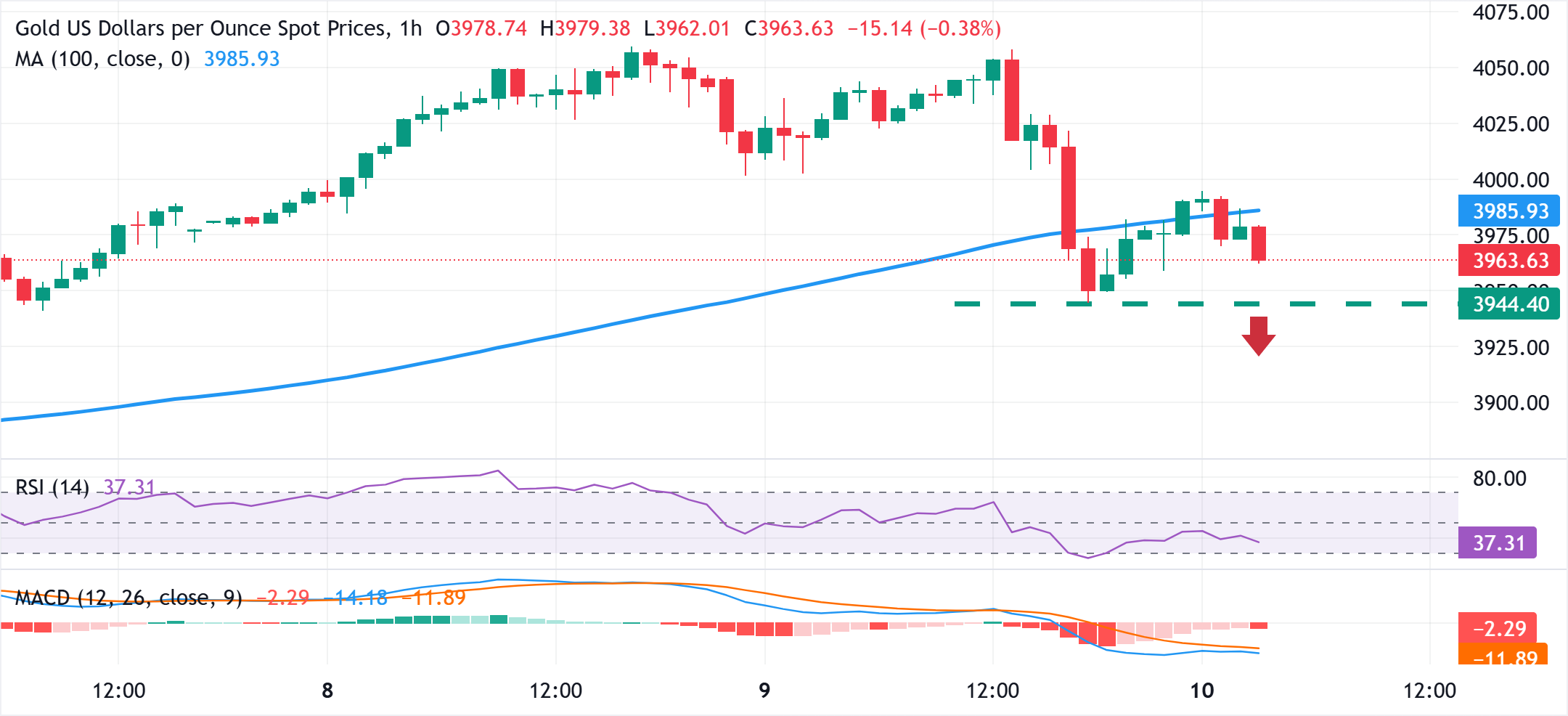Gold remains under pressure below $4,000; downside potential seems limited
- Gold sticks to its negative bias for the second straight day, though it lacks follow-through selling.
- The USD retreats slightly from an over two-month peak and acts as a tailwind for the commodity.
- Fed rate cut bets, the US government shutdown, and geopolitical risks support the precious metal.
Gold (XAU/USD) remains depressed below the $4,000 psychological mark during the Asian session on Friday. However, the fundamental backdrop warrants some caution before positioning for an extension of the previous day's retracement slide from the all-time peak. The US Dollar (USD) pulls back slightly after registering strong weekly gains to its highest level since early August, and could support the commodity. Furthermore, bets for more interest rate cuts by the US Federal Reserve (Fed) and concerns about the US government shutdown act as a tailwind for the precious metal.
Apart from this, the cautious market mood might further contribute to limiting any meaningful corrective decline for the safe-haven Gold on the back of rising trade and geopolitical tensions. However, the lack of follow-through buying warrants some caution for the XAU/USD bulls and positioning for an extension of the recent well-established uptrend amid still overbought conditions. Nevertheless, the yellow metal remains on track to register strong gains for the eighth straight week as traders look to more comments from influential FOMC members for short-term opportunities.
Daily Digest Market Movers: Gold bulls remain on the sidelines despite a supportive fundamental backdrop
- The US Dollar rose to its highest level since early August on Thursday, prompting the XAU/USD bulls to take some profits off the table following the recent record-setting rally. Adding to this, a ceasefire deal between Israel and Hamas turned out to be another factor that contributed to the safe-haven Gold's overnight downfall.
- Federal Reserve Chair Jerome Powell offered no fresh policy signals, while Minutes from the September FOMC meeting released on Wednesday showed lingering inflation concerns. Traders, however, are still pricing in a greater chance that the US central bank will lower borrowing costs two more times by the end of this year.
- The government shutdown is now in its second week amid few signs of progress toward a deal to advance funding bills. The Senate rejected motions to advance competing bills for the seventh time on Thursday and will not hold any further votes until at least next week, when the upper chamber is expected to return on Tuesday.
- US President Donald Trump said Thursday that Washington and NATO allies were stepping up the pressure to end the war in Ukraine. Ukraine reported a large-scale Russian assault on Kyiv early Friday, involving ballistic missiles and drone strikes, which targeted critical infrastructure and caused widespread power outages.
- This keeps geopolitical risks in play and largely offsets the optimism led by the Israel-Hamas agreement on the first phase of the Gaza peace plan. Apart from this, a modest USD downtick supports the precious metal, which seems poised to register gains for the eighth consecutive week amid a supportive fundamental backdrop.
Gold could retreat further from the all-time peak as the 100-hour SMA breakdown comes into play

The overnight breakdown and acceptance below the 100-hour Simple Moving Average (SMA) could be seen as the first sign of a bullish exhaustion. That said, it will still be prudent to wait for some follow-through selling below the overnight swing low, around the $3,944 region, before positioning for any meaningful corrective decline. The Gold price might then accelerate the downfall towards testing the $3,900 round-figure mark.
On the flip side, any intraday positive move beyond the $4,000 mark is likely to confront a hurdle near the $4,035-4,036 region ahead of the $4,059-4,060 area, or the all-time peak touched on Wednesday. Some follow-through buying will be seen as a fresh trigger for bulls and lift the Gold price towards the $4,100 round-figure mark.
Gold FAQs
Gold has played a key role in human’s history as it has been widely used as a store of value and medium of exchange. Currently, apart from its shine and usage for jewelry, the precious metal is widely seen as a safe-haven asset, meaning that it is considered a good investment during turbulent times. Gold is also widely seen as a hedge against inflation and against depreciating currencies as it doesn’t rely on any specific issuer or government.
Central banks are the biggest Gold holders. In their aim to support their currencies in turbulent times, central banks tend to diversify their reserves and buy Gold to improve the perceived strength of the economy and the currency. High Gold reserves can be a source of trust for a country’s solvency. Central banks added 1,136 tonnes of Gold worth around $70 billion to their reserves in 2022, according to data from the World Gold Council. This is the highest yearly purchase since records began. Central banks from emerging economies such as China, India and Turkey are quickly increasing their Gold reserves.
Gold has an inverse correlation with the US Dollar and US Treasuries, which are both major reserve and safe-haven assets. When the Dollar depreciates, Gold tends to rise, enabling investors and central banks to diversify their assets in turbulent times. Gold is also inversely correlated with risk assets. A rally in the stock market tends to weaken Gold price, while sell-offs in riskier markets tend to favor the precious metal.
The price can move due to a wide range of factors. Geopolitical instability or fears of a deep recession can quickly make Gold price escalate due to its safe-haven status. As a yield-less asset, Gold tends to rise with lower interest rates, while higher cost of money usually weighs down on the yellow metal. Still, most moves depend on how the US Dollar (USD) behaves as the asset is priced in dollars (XAU/USD). A strong Dollar tends to keep the price of Gold controlled, whereas a weaker Dollar is likely to push Gold prices up.
